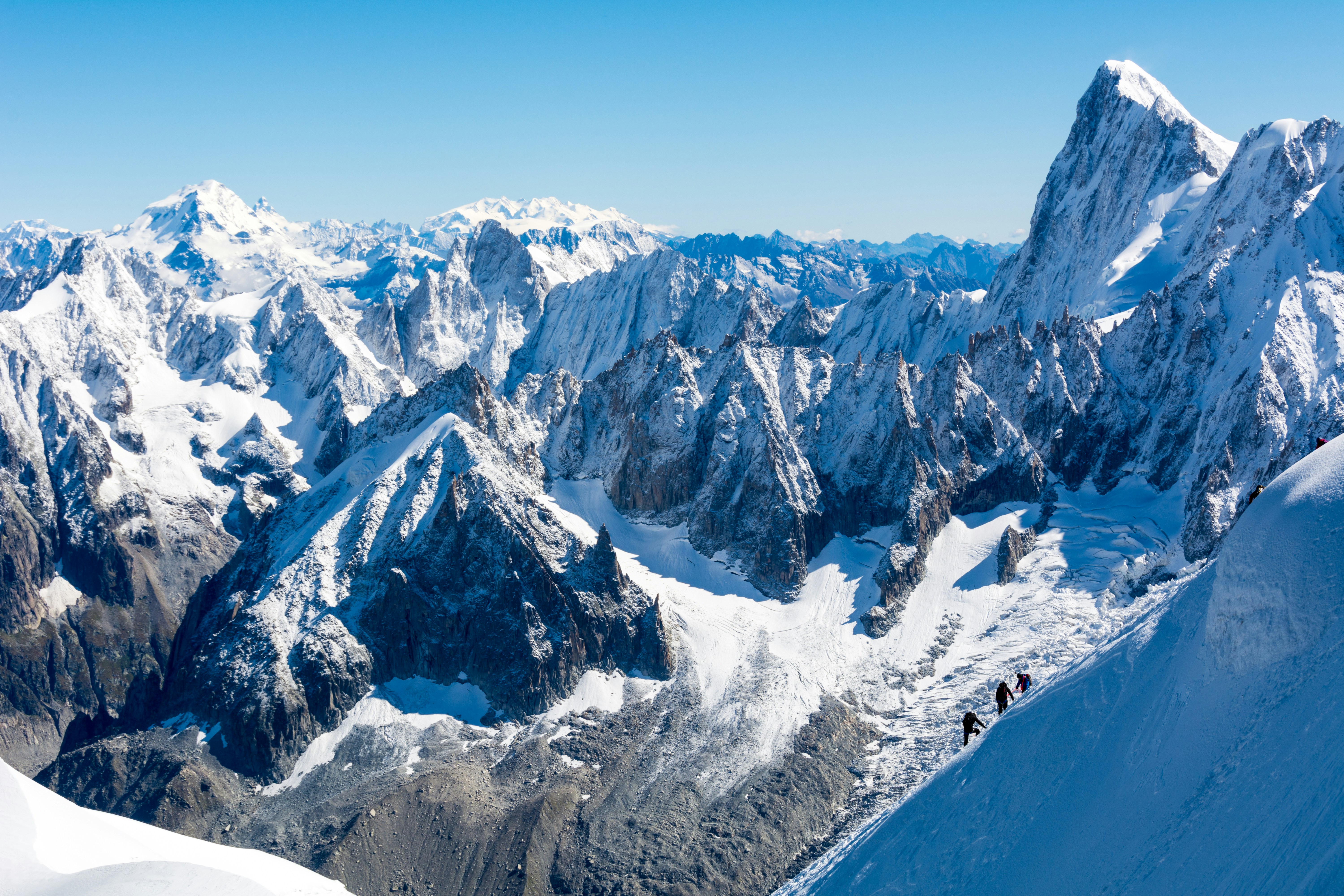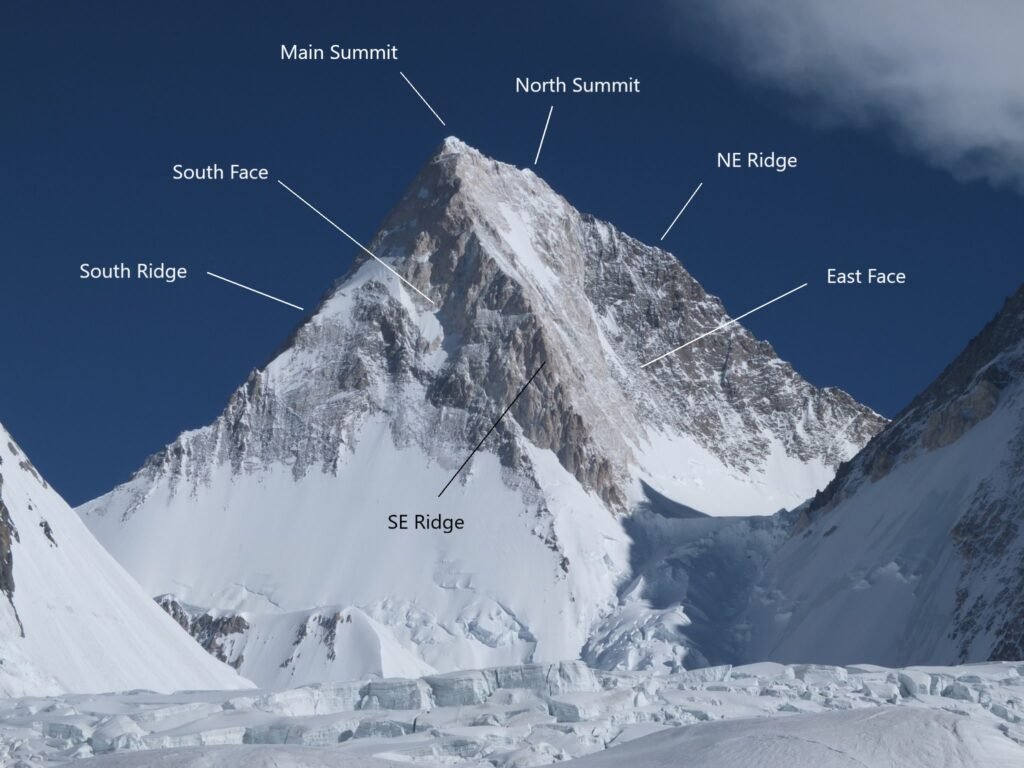
The Origins of the Name Gasherbrum
The name ‘Gasherbrum’ (ག་ཞར་པུ་རུམ་) holds a significant place in the lexicon of mountainous regions, with its roots embedded in the Balti language spoken in Northern Pakistan. The etymology of this majestic mountain’s name stems from two components: ‘rgasha’, (གར་ཤ་) meaning beautiful, and ‘brum’་ (བུ་རི) , which translates to mountain. When combined, these terms convey the essence of the peak as a ‘beautiful mountain’, a fitting description for a site that commands awe and admiration from climbers and nature lovers alike.
It is essential to dispel the common misconception that ‘Gasherbrum’ means ‘shining wall’. This interpretation may have arisen from various translations over the years, possibly due to the mountain’s impressive, striking scenery and challenging vertical faces that could metaphorically resemble a wall. However, understanding the actual Balti roots offers a richer and more authentic appreciation of the peak. By acknowledging the correct meaning, one can gain insight not only into the mountain itself but also into the culture and language of the local people who view the mountain as part of their heritage.
Historical context also plays a critical role in understanding the name Gasherbrum. The mountain, part of the Karakoram range, has been an integral aspect of local culture and identity for centuries. Names often reflect the characteristics of their environment, and the beauty of Gasherbrum, as perceived by the Balti people, illustrates this link between human perception and natural wonders. Furthermore, the Balti language showcases the deep connection between the people and their land, emphasizing how geographical features inspire language and culture. Recognizing this heritage enriches the relationship that visitors and climbers have with Gasherbrum, providing a deeper sense of respect and understanding for the mountain’s majesty.
Tibetan Name : Mount Gasherbrum
In the Tibetan language:
- “Gasher” (often written as དགའ་ཤེས་ or གར་ཤ་ similar transliterations, though spellings vary) is indeed used in old Tibetan texts to refer to the region of present-day Kashmir, and sometimes includes Lahaul (now in Himachal Pradesh) and surrounding Himalayan borderlands.
- “Brum” (written in Tibetan as བྲུམ་ or བྲུམས་) can be interpreted as “spread over” or “highland(s)” in older Tibetan usage. It’s a bit archaic but shows up in place names or poetic language.
So when Tibetan sources mention “Gasher Brum”, it can be interpreted as:
“The mountains of Gasher” or “Mountainous region of Kashmir/Lahaul”
This phrase would traditionally point to the western Himalayan region, including parts of what are now Kashmir, Lahaul-Spiti, and even western Tibet, depending on historical context.

The Gasherbrum Peaks: An Overview
The Gasherbrum peaks, part of the majestic Karakoram range, are located in the northern region of Pakistan, specifically at the northeast end of the Baltoro Glacier. This stunning massif comprises a total of six significant peaks, with Gasherbrum I being the highest at an impressive elevation of 8,080 meters. Its prominence within the region is not only due to its height but also because it is often recognized as the 11th highest mountain globally. Climbers from around the world are drawn to this peak, seeking the challenge it presents amidst the breathtaking backdrop of the Karakoram.
In addition to Gasherbrum I, the massif includes Gasherbrum II, which stands at 8,035 meters and is the 13th highest mountain in the world. Like its counterpart, Gasherbrum II presents a captivating allure for mountaineers, known for its steep faces and technical challenges. Further complementing the awe-inspiring heights are peaks such as Gasherbrum III, which reaches 7,952 meters, and Gasherbrum IV, at 7,925 meters, showcasing a range of climbing experiences and breathtaking views.
Additionally, Gasherbrum V peaks at 7,746 meters and Gasherbrum VI reaches 7,752 meters, rounding out the entire massif. These five peaks, along with Gasherbrum I, share the distinct characteristics of the Karakoram mountains, including glaciated slopes and weather conditions that can change rapidly. The accessibility of these peaks, particularly through established trekking routes leading to the Baltoro Glacier, enhances their appeal to adventurers and researchers alike, eager to explore the natural beauty and geological wonders of the region.

Climbing Gasherbrum: History and Challenges
The first ascent of Gasherbrum I, the highest peak in the Gasherbrum massif, marked a significant milestone in the history of high-altitude climbing. Accomplished by an American expedition led by Nick Clinch in 1958, this ascent introduced climbers to the harsh realities of tackling one of the most formidable peaks in the Karakoram range. Clinch and his team faced numerous challenges, from unpredictable weather patterns to technical climbing routes that would test their skills and resolve. This pioneering expedition laid the groundwork for future attempts, igniting interest in the Gasherbrum region.
Climbing Gasherbrum I requires not only excellent technical climbing skills but also a deep understanding of the mountain’s unique challenges. The remote location of Gasherbrum, lying in northeastern Pakistan, significantly contributes to its difficulty. Approaching the mountain often involves lengthy treks through rugged terrain. Climbers must possess advanced skills in rock and ice climbing, as well as a profound comprehension of altitude acclimatization. Furthermore, navigating the perilous weather conditions characteristic of the Karakoram presents an additional layer of complexity.
Equipment selection is critical for a successful ascent of Gasherbrum. Essential gear includes high-altitude mountaineering boots, crampons, ice axes, and specialized climbing hardware. Moreover, due to the unpredictable weather and the mountain’s steep, glaciated routes, climbers should be well-versed in self-rescue techniques and emergency protocols. A commitment to physical training and mental preparation is paramount, as climbers will face extended periods in high-altitude environments where every decision can greatly influence success or failure.
Thus, aspiring climbers should approach the challenge of summiting Gasherbrum with thorough preparation and respect for the mountain’s formidable reputation. Understanding the historical context and the inherent challenges associated with this magnificent peak will provide invaluable insights for those willing to take on this climbing endeavor.
Cultural Significance and Notable Peaks
The Gasherbrum region, located in the majestic Karakoram Mountain Range, is not only celebrated for its breathtaking geological formations but also for its deep cultural significance. Local inhabitants, including the Balti people, possess a profound emotional and spiritual connection to these towering giants. For them, the mountains are sacred entities, embodying both challenges and the beauty of their surroundings. The peaks of Gasherbrum, particularly Gasherbrum II and III, are revered, with each having distinct personalities shaped by their unique topography and challenges they present to climbers.
The aesthetic beauty of Gasherbrum is captivating, especially during the twilight hours of sunrise and sunset. As the sun rises, the mountains reflect hues of gold and pink, creating a dramatic silhouette against the sky. At sunset, the peaks are bathed in an enchanting glow, further enhancing their majestic presence. This natural beauty serves not only as a backdrop for climbers and trekkers but also as a source of inspiration for local artists and storytellers, who weave the tales of these mountains into their cultural fabric.
Gasherbrum II, standing at approximately 8,035 meters, is one of the notable peaks of the range, recognized for its steep faces and challenging routes. It draws mountaineers from around the globe, not just for its technical difficulties but also for the sense of accomplishment that comes from reaching its summit. On the other hand, Gasherbrum III, slightly lower at 7,952 meters, is often seen as more accessible yet still formidable in its own right. The climbs require both physical endurance and mental fortitude, reflecting the mountains’ ability to teach important life lessons through the arduous journey of ascent.
In essence, the peaks of Gasherbrum resonate with the cultural identity of the region, transcending their physical attributes and becoming symbols of beauty, challenge, and spiritual significance for the communities that share their landscape.


